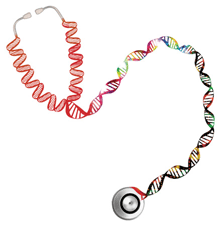Research Matters
January 28, 2008 Genes Influence Blood Lipid Levels and Heart Disease RiskBlood levels of lipids like cholesterol and triglycerides are important risk factors for coronary artery disease. Scientists know about certain lifestyle factors—such as smoking, diet and physical activity—that affect blood lipid levels, but the role of genetics hasn’t been well understood. A large study has now revealed more than 25 genetic variants in 18 genes connected to blood cholesterol and lipid levels. The finding may lead to new strategies for treating and preventing coronary artery disease.  Image by Jane Ades, NHGRI.
High levels of low-density lipoprotein (LDL, or "bad" cholesterol) appear to increase the risk of coronary artery disease by narrowing arteries that carry blood to the heart. High levels of triglycerides, which make up a large part of the body's fat, are also associated with an increased risk of heart disease. In contrast, high levels of high-density lipoprotein (HDL, or "good" cholesterol) seem to lower the risk. An international team of scientists, supported primarily by NIH, set out to identify the genetic factors that play a role in setting these blood lipid levels. The researchers turned to a relatively new approach known as a genome-wide association study (GWAS). They surveyed the entire human genetic blueprint, or genome, for genetic variants that influence lipid levels. Members of the SardiNIA Study of Aging, including investigators at NIH's National Institute on Aging (NIA), conducted the study, working with members of the Finland-United States Investigation of Non-Insulin-Dependent Diabetes Mellitus Genetics (FUSION) study, which included investigators from NIH's National Human Genome Research Institute (NHGRI). SardiNIA and FUSION investigators coordinated the efforts of other groups in France, the United Kingdom and across the United States to use the statistical power of new software programs to pool and analyze genetic data from more than 20,000 people. The data came from studies supported by NIA, NHGRI and other NIH components. The team reported online on January 13, 2008, in Nature Genetics that it found variations in 18 genes that influence HDL, LDL and triglyceride levels. Seven of the genes had not previously been connected to blood lipid levels. Of the newly implicated genes, 2 were associated with HDL levels, 1 with LDL levels, 3 with triglyceride levels and 1 with both triglycerides and LDL levels. To see if the genetic variants linked to lipid levels also influence the risk of heart disease, the researchers compared their findings with results from the Wellcome Trust Case Control Consortium's recent GWAS findings for coronary artery disease. They found that all the gene variants associated with increased LDL levels were also more prevalent among people with coronary artery disease. People with the gene variant for high triglyceride levels had an increased risk for coronary artery disease as well, although the relationship was not as strong. No relationship was seen with HDL. Scientists estimate that the genetic contribution to lipid levels is about 30-40%. The genetic variants uncovered in this study are responsible for only about 5-8% of that contribution, the scientists note. There's still more work to be done to understand the genetic contributions to blood lipid levels and coronary artery disease. Related Links:
This week's NIH Research Matters Genes Influence Blood Lipid Levels and Heart Disease Risk This page was last updated
July 2, 2008
.
|



